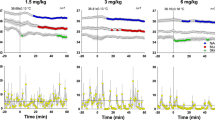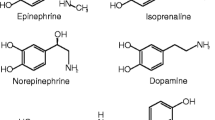Abstract
During halothane-induced malignant hyperthermia (MH), plasma levels of serotonin (5-hydroxytryptamine, 5-HT) increase in pigs. Administration of 5-HT agonists which stimulate the 5-HT2A subreceptor triggers MH in susceptible pigs. A possible link between MH induced by 5-HT2A receptor agonists and halothane could be an increase of second messengers such as phosphoinositides (inositol polyphosphates), which have recently been implicated in the abnormal regulation of skeletal muscle calcium release in MH. If so, antagonists of 5-HT2A receptors which are linked to phosphoinositide turnover should, be capable of preventing, retarding or attenuating halothane-induced MH. This possibility was investigated in the present study in MH susceptible pigs, using dantrolene for comparison. Development of MH triggered by a halothane challenge (inhalation of 3% halothane for 15 min) was completely prevented by dantrolene, 3.5 mg/i.v., whereas the 5-HT2A receptor antagonists ritanserin (0.5–10 mg/kg i.v.) or ketanserin (0.5–10 mg/kg i.v.) exerted no prophylactic effect. In pigs in which dantrolene, ritanserin or ketanserin where given in combination with hyperventilation after development of MH, dantrolene exerted therapeutic efficacy, whereas neither ritanserin nor ketanserin were effective treatments. The data indicate that 5-HT is not critically involved in the mechanisms of halothane-induced MH, at least under the conditions of the present experimental study.
Similar content being viewed by others
Abbreviations
- AST:
-
aspartate aminotransferase
- CK:
-
creatinkinase
- 5-HT:
-
5-hydroxytryptamine
- 5-MeO-DMT:
-
5-methoxy-N,N-dimethyltryptamine
- MH:
-
malignant hyperthermia
- MHA:
-
MH-atypical
- MHN:
-
MH-nonsusceptible
- MHS:
-
MH-susceptible
References
Aghajanian GK, Sprouse JS, Rasmussen K (1987) Physiology of the midbrain serotonin system. In: Meltzer Y (ed) Psychopharmacology — The Third Generation of Progress. Raven Press, New York, pp 141–149
Anisman H, Kokkinidis L, Sklar LS (1985) Neurochemical consequences of stress. In: Burchfiel S (ed) Stress: psychological and physiological interactions. Hemisphere, Washington, pp 67–98
Ball SP, Johnson KJ (1993) The genetics of malignant hyperthermia. J Med Gen 30:89–93
Behan WHM, Bakheit AMO, Behan PO, More IAR (1991) The muscle findings in the neuroleptic malignant syndrome associated with lysergic acid diethylamide. J Neurol Neurosurg Psychiatr 54:741–743
Donaldson SK, Goldberg ND, Walseth TF, Huetteman DA (1988) Voltage dependence of inositol 1,4,5-triphosphate-induced Ca2+ release in peeled skeletal muscle fibers. Proc Natl Acad Sci USA 85:5749–5753
Fletcher JE, Calvo PA, Rosenberg H (1993) Phenotypes associated with malignant hyperthermia susceptibility in swine genotyped as homozygous or heterozygous for the ryanodine receptor mutation. Br J Anaesth 71:410–417
Foster PS (1990) Malignant hyperpyrexia. Int J Biochem 22:1217–1222
Gerdes C, Richter A, Armies R, Loscher W (1992) Increase of serotonin in plasma during onset of halothane-induced malignant hyperthermia in pigs. Eur J Pharmacol 220:91–94
Gerdes C, Richter A (1992) Prophylaxis and treatment of halothane-induced malignant hyperthermia: Comparison of dantrolene and serotonin antagonists. Naunyn-Schmiedeberg's Arch Pharmacol 345 [Suppl]:R114
Gerdes C (1992) Die Rolle des Serotoninsystems bei der Induktion der durch Halothan ausgelösten malignen Hyperthermie beim Schwein. Doctoral Thesis, School of Veterinary Medicine, Hannover
Gronert GA, Mott J, Lee J (1988) Aetiology of malignant hyperthermia. Br J Anaesth 60:253–267
Huckel VF, Staniloff HM, Britt BA, Waxmann MB, March JE (1982) Electrocardiographic abnormalities associated with malignant hyperthermia susceptibility. J Electrocardiol 15:137–141
Humphrey PPA, Hartig P, Hoyer D (1993) A proposed new nomenclature for 5-HT receptors. Trends Pharmacol Sci 14:233–226
Jacobs BL, Azmitia EC (1992) Structure and function of the brain serotonin system. Physiol Rev 72:165–229
Janssen PAJ (1983) 5-HT2 receptor blockade to study serotonin-induced pathology. Trends Pharmacol Sci 4:198–207
Joffe M, Savage N, Silove M (1992) The biochemistry of malignant hyperthermia: recent concepts. Int J Biochem 24:387–398
Lehmacher W, Wassmer G, Reitmer P (1991) Procedures for two-sample comparisons with multiple endpoints controlling the experiment-wise error rate. Biometrics 47:511–521
Lehmacher W (1988) Analyse von K Stichproben von Verlaufskurven. In: Überla K, Rienhoff O, Victor N (eds) Medizinische Informatik und Statistik. Springer, Berlin Heidelberg New York, pp 34–47
Leysen JE, Gommeren W, van Gompel P, Wynants J, Janssen PFM, Laduron PM (1985) Receptor-binding properties in vitro and in vivo of ritanserin. A very potent and long acting serotonin-S2 antagonist. Mol Pharmacol 27:600–611
Lopez JR, Parra L (1991) Inositol 1,4,5-triphosphate increases myoplasmic [Ca2+] in isolated muscle fibers. Depolarization enhances its effects. Cell Calcium 12:543–557
Löscher W, Witte U, Fredow G, Ganter M, Bickhardt K (1990a) Pharmacodynamic effects of serotonin (5-HT) receptor ligands in pigs: stimulation of 5-HT2 receptors induces malignant hyperthermia. Naunyn-Schmiedeberg's Arch Pharmacol 341:483–493
Löscher W, Witte U, Fredow G, Traber J, Glaser T (1990b) The behavioural response to 8-OH-DPAT, ipsapirone and the novel 5-HT1A receptor agonist BAY Vq 7813 in the pig. Naunyn-Schmiedeberg's Arch Pharmacol 342:271–277
MacLennan DH, Phillips MS (1992) Malignant hyperthermia. Science 256:789–794
McGrath JC, Lee CJ, Ashen MD (1985) Azaperone (stresnil) in malignant hyperthermia (MH) susceptible swine: determination of protective effects to halothane challenge and toxicity. Vet Surg 14:75
Meltzer HY, Matsubara S, Lee J-C (1989) Classification of typical and atypical antipsychotic drugs on the basis of dopamine D-1, D-2 and serotonin2 pKi values. J Pharmacol Exp Ther 251:238–243
Moretti-Rojas I, Ezrailson Eg, Birnbaumer L, Entman ML, Garber AJ (1983) Serotonergic and adrenergic regulation of skeletal muscle metabolism in the rat. II. The use of [125I]iodolysergic acid diethylamide and [125I] iodopindolol as probes of sarcolemmal receptor function and specificity. J Biol Chem 258:12499–12508
Ooms L, Awouters F, Degryse A, Jageneau T (1983) Serotonin and S2 antagonists in veterinary medicine. In: Ruckebusch Y, Toutain P-L, Koritz GD (eds) Veterinary pharmacology and toxicology. MTP Press, Boston, pp 263–281
Ooms L, Awouters F (1982) Serotonin and serotonin 2 antagonists; pharmacology and veterinary applications. Pharmacol Toxicol Vet 8:433–436
Ording H, Hald A, Sjontoft E (1986) Ketanserin and malignant hyperthermia in pigs. Acta Anaesthesiol Scand 30:7–9
Peroutka SJ (1988) 5-Hydroxytryptame receptor subtypes: molecular, biochemical and physiological characterization. Trends Neurosci 11:496–500
Peroutka SJ (1993) 5-Hydroxytryptamine receptors. J Neurochem 60:408–422
Richter A, Gerdes C, Löscher W (1992) Atypical reactions to halothane in a subgroup of homozygous malignant hyperthermia(MH)-susceptible pigs: Indication of a heterogenous genetic basis for the porcine syndrome. Dtsch Tierdrztl Wochenschr 99:401–406
Roewer (1992) Herz and Kreislauf bei maligner Hyperthermie. Springer, Berlin Heidelberg New York
Shimizu N, Take S, Hori T, Oomura Y (1992) In vivo measurement of hypothalamic serotonin release by intracerebral microdialysis —Significant enhancement by immobilization stress in rats. Brain Res Bull 28:727–734
Stanley TH, Port JD, van der Maatin J, Kimball J (1984) Treatment of malignant hyperpyrexia with a serotonin receptor blocker. Anesthesiology 61 [Suppl]:A384
Sternbach H (1991) The serotonin syndrome. Am J Psychiatr 148:705–713
Topel DG, Wilson DG, Weiss GM, Christian LL (1973) Influence of phenoxybenzamine and propranolol on blood scrotonin and pH, plasma cortisol and M. longissimus pH and color in swine. J Anim Sci 36:1077–1080
Vilven J, Coronado R (1988) Opening of dihydropyridine calcium channels in skeletal muscle membranes by inositol triphosphate. Nature 336:587–589
Williams CH, Dozier SE, Farias M (1988) Hemodynamics in malignant hyperthermia susceptible pigs during malignant hyperthermia. In: Williams C (ed) Experimental malignant hyperthermia. Springer, New York Berlin Heidelberg, pp 30–45
Author information
Authors and Affiliations
Additional information
Correspondence to: W. Loscher at the above address
Rights and permissions
About this article
Cite this article
Löscher, W., Gerdes, C. & Richter, A. Lack of prophylactic or therapeutic efficacy of 5-HT2A receptor antagonists in halothane-induced porcine malignant hyperthermia. Naunyn-Schmiedeberg's Arch Pharmacol 350, 365–374 (1994). https://doi.org/10.1007/BF00178953
Received:
Accepted:
Issue Date:
DOI: https://doi.org/10.1007/BF00178953




